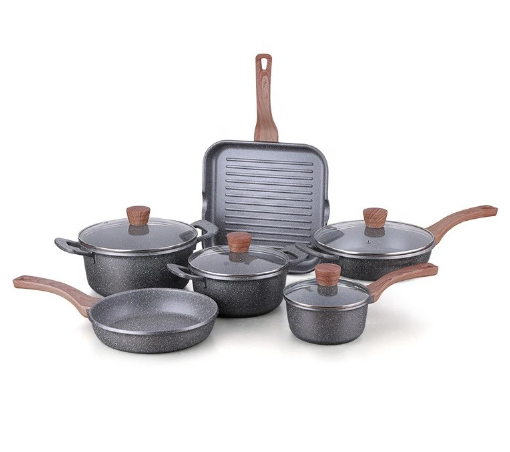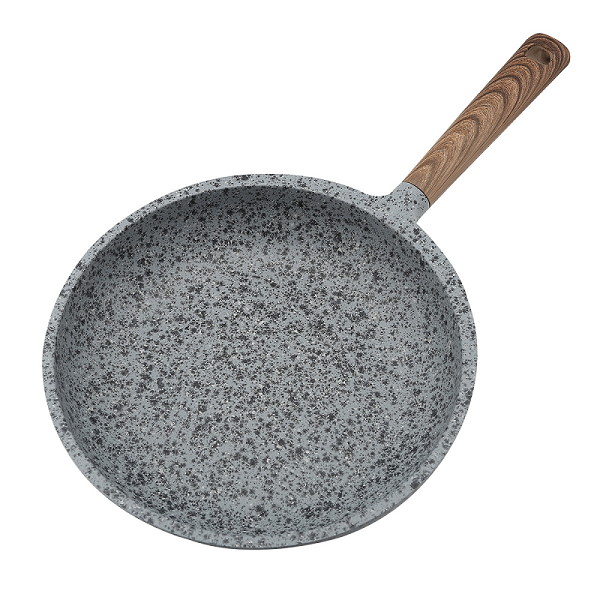Die casting is a type of manufacturing method often used to make cookware, which offers some benefits. Here we’ll get into the die cast cookware safety, benefits, and the difference between die cast and cast iron cookware.

What Is Die Cast Cookware?
Die cast cookware is made by injecting molten metal (usually aluminum) into a mold under high pressure. The resulting product is a durable, non-stick surface that can be used for a variety of cooking tasks. Die cast cookware is known for its ability to distribute heat evenly and withstand high temperatures, making it a popular choice among home cooks and professional chefs alike.

Is die cast aluminum cookware safe?
Die cast cookware is generally safe to use as long as it is made with food-grade materials and is used properly. Most die cast cookware is made from aluminum, which is a safe material for cooking. However, some low-quality die cast cookware may contain harmful chemicals such as lead or cadmium, so it is important to choose a reputable brand. When using die cast cookware, it is also important to avoid overheating the pan or using metal utensils that can scratch the non-stick coating, which can release potentially harmful chemicals.
Die Cast Cookware Benefits
– Durability: Die cast cookware is made from materials that are durable and can withstand high temperatures, making it long-lasting.
– Heat distribution: The casting process creates a uniform surface that distributes heat evenly, resulting in consistent cooking.
– Non-stick properties: Many die cast cookware products have a non-stick coating that makes cooking and cleaning easier.
– Versatility: Die cast cookware is suitable for use on a variety of stove tops, including gas, electric, and induction.
– Easy to clean: The non-stick coating on many die cast cookware products makes them easy to clean, often just requiring a simple wipe-down.
– Lightweight: Despite its durability, die cast cookware is relatively lightweight, making it easy to handle in the kitchen.
Read related: Best Die Cast Cookware 2025 – Top 5 Best Die-cast Cookwares & Pans
Die Casting Cookware Types
Die cast cookware is often categorized by the type of coating applied to its surface. The coating affects nonstick performance, durability, heat resistance, and cleaning ease. So below the the main Die Casting Cookware types in the marketing by coating:
| Coating Type | Description | Pros | Cons | Common Uses |
|---|---|---|---|---|
| PTFE (Traditional Nonstick) | Polytetrafluoroethylene (e.g., Teflon); smooth, slick surface | Excellent nonstick; easy cleanup; low oil needed | Can degrade at high heat; avoid metal utensils | Fry pans, saucepans |
| Ceramic Nonstick | Silica-based, “ceramic” finish; usually white or colored | Free from PTFE/PFOA; good scratch resistance; eco image | May lose nonstick over time; avoid high heat | Fry pans, griddles, woks |
| Granite/Stone-look Coating | PTFE or ceramic base with mineral “stone” particles or speckled appearance | Attractive; sometimes harder/scratch-resistant | “Granite” is just the look; real stone is rare | Fry pans, casseroles |
| Titanium-reinforced Nonstick | Nonstick coating infused with titanium particles for extra durability | Durable; more scratch-resistant; long-lasting | More expensive than regular nonstick | Fry pans, sauté pans |
| Diamond-reinforced Nonstick | Coating contains diamond dust/crystals for added hardness | Extremely hard; very scratch-resistant | Premium price; still synthetic base | Fry pans, grill pans |
| Enamel Coating | Glassy, colorful layer fused to the metal | Attractive; resists staining; good for acidic foods | Can chip/crack; not nonstick | Dutch ovens, baking dishes |
| No Coating / Bare | Sometimes die cast cookware is left uncoated (rare) | No chemicals; can season like cast iron | Needs seasoning; can stick; may corrode | Specialty pans, grills |
Is Granite Die Casting Cookware Safe?
Granite Die Cast Cookware is one of the most popular types of nonstick die-cast cookware in the market now, as it is easy to clean and usually scratch-resistant (though not as tough as actual stone). The cookware itself is made from die cast aluminum, which means molten aluminum is forced into a mold under high pressure to create the pan or pot. This process results in durable, lightweight cookware with excellent heat distribution. The term “granite” refers to the appearance and/or the type of nonstick coating applied to the surface of the die cast aluminum. The “granite” look is achieved by using a speckled, stone-like nonstick coating (usually PTFE or ceramic reinforced with minerals for durability and scratch resistance). Sometimes, the coating is called “granite” because it contains small amounts of stone-derived minerals, but it is still mostly a synthetic nonstick layer.

So, Is It Safe? We would like to explain its safety in different factors:
1. Food-Contact Safety
- Most modern granite-coated cookware is PFOA-free (perfluorooctanoic acid, a chemical phased out due to health concerns). If you’re buying from a reputable brand, the coating should be food-safe and non-reactive under typical cooking temperatures.
2. Temperature Limits
- PTFE-based granite coatings: Safe up to around 260°C (500°F). Overheating can cause the coating to break down and release fumes (potentially harmful in large amounts, especially for birds).
- Ceramic-based granite coatings: Often tolerate slightly higher temperatures, but nonstick properties can degrade above recommended heat.
3. Scratches and Wear
- Do not use metal utensils; scratching the coating can reduce its nonstick effect and, over time, expose the underlying metal. If the coating is badly damaged or flaking, replace the pan.
4. Aluminum Exposure
- The die cast aluminum base is not exposed as long as the coating is intact, so aluminum leaching is not a concern.
Die Cast vs Cast Iron Cookware, What Are the Differences
– Material: Die cast cookware is made from molten metal (typically aluminum) that is injected into a mold, while cast iron cookware is made from solid iron that is melted and poured into a mold.
– Weight: Cast iron cookware is generally heavier than die cast cookware because of the density of the iron.
– Heat retention: Cast iron cookware is known for its exceptional heat retention, which allows it to stay hot for a long time after being removed from the heat source. Die cast cookware does not retain heat as well as cast iron.
– Seasoning: Cast iron cookware often requires seasoning (a process of coating the surface with oil and baking it) to create a non-stick surface and prevent rusting. Die cast cookware typically comes with a non-stick coating that does not require seasoning.
– Price: Cast iron cookware is generally more expensive than die cast cookware.
– Versatility: Cast iron cookware can be used both on the stove top and in the oven, while die cast cookware is generally not oven-safe.
Die Cast Cookware vs Regular Cookware, Which is Better?
The choice between die cast cookware and regular cookware depends on your cooking needs, preferences, and budget.
Die cast cookware:
Pros – Even heat distribution, durability, easy to clean, lightweight, and sometimes have non-stick properties.
Cons – Higher price point, may not withstand extremely high temperatures.
Regular cookware:
Pros – Widely available, lower price point, can be made with a variety of materials, can be used with high temperatures.
Cons – Uneven heat distribution, lower durability, can be difficult to clean, may require seasoning and oiling to prevent sticking.
Die Cast Cookware vs Granite Cookware, Which is Better?
| Feature | Die Cast Cookware | Granite Cookware |
|---|---|---|
| Material | Die-cast aluminum (sometimes iron) | Metal base with granite-like coating |
| Weight | Medium to Heavy | Lightweight |
| Heat Distribution | Excellent | Good |
| Non-Stick | Usually non-stick coated | Non-stick due to enamel/coating |
| Durability | Very durable, resists warping | Coating can chip if mishandled |
| Maintenance | Easy (hand wash recommended) | Easy (avoid metal utensils) |
| Reactivity | Non-reactive if coated | Non-reactive |
| Oven Safe | Usually, check handle material | Often oven safe, check specs |
| Price | Moderate to high | Moderate |
- If you want long-lasting, sturdy cookware with excellent heat distribution, die cast cookware is a solid choice.
- If you prefer lightweight, non-reactive, and easy-to-clean cookware (with a stylish look), granite cookware is a great pick.

